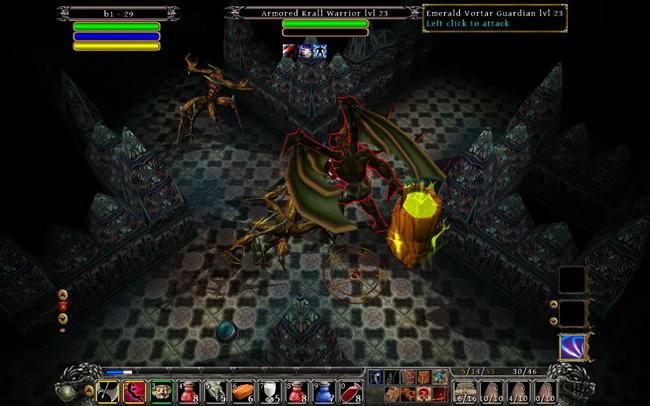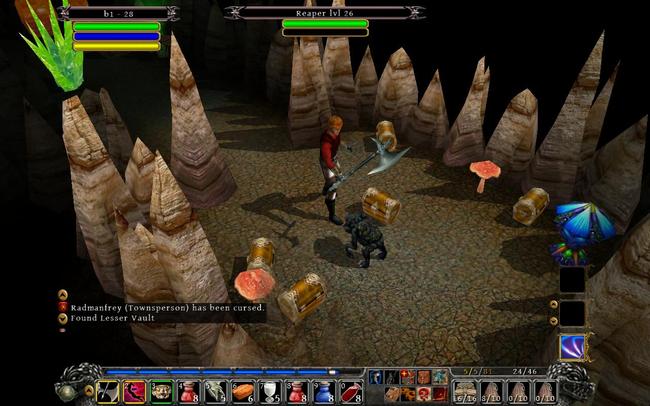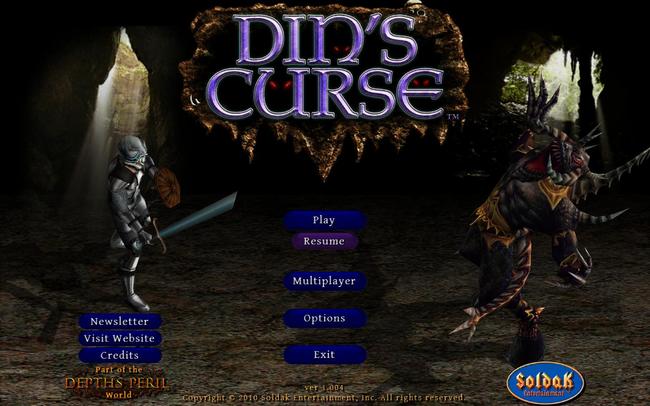
Din's Curse Review
Nostalgia has become a powerful factor within gaming these past few years, especially for games colloquially referred to as "Diablo clones". Since the announcement of Diablo III in 2008, there's been a popular resurgence in Diablo's brand of dungeon crawling and loot collecting.
To capitalise on the sucess of the Diablo clone comes Din's Curse, courtesy of indie developer Soldak Entertainment, but is this a curse or a blessing in disguise?
In the mysterious world of Aleria, champion of the gods Din has cursed you into living a second life for squandering your first one. To gain favor with Din you are tasked to wander the world and rebuild your rather crap reputation by helping strangers and killing monsters.
After picking your class from a large list of various fantasy RPG classes (warrior, rogue, priest, wizard, ranger, etc) you're plunked down into the middle of a town under siege by monsters and demons. It seems building a town on top of a large demon hive was a rather bad idea.

Every NPC in town has something to say, but what you're really there for are the quests, of which there are a multitude. These range from collecting X amounts of monster limb Y, feeding an NPC (as we know, NPCs can only stand still in one place), killing a specific enemy or donating money to a certain NPC. And for the entirety of the game, this is all you will be doing.
New quests are randomly generated on the fly, and some of them have a strict time limit giving the game world a dynamic feel to it. Unfortunately the quests do get rather tedious at one point, and while there are consequences to failing your quests, on the normal difficulty these seem rather innocuous in the grand scheme of things. Once you've completed enough quests in a single town, or slain the big bad demon in charge, Din will allow you to move onto the next one where you get to do everything all over again. Do this enough times and the curse is lifted.
It's probably obvious from the last paragraph that the story isn't the game's strongest suit. What most players will gravitate towards are the endless amounts of quests and loot you'll pick up. As you venture ever downwards through the game's randomly generated dungeons you'll pick up increasing amounts of loot and gear, most of which you won't be able to equip if you've chosen the wrong class.
All classes come with predetermined equipment skills, but class specific attacks, buffs and passive skills are chosen by the player, letting you design the character you want to play. With a total of over 140 class combinations there's plenty to choose from, and a lot to sink your teeth into if you're an old-school RPG fan.
You can also choose the game's difficulty, the monsters' starting level, various character handicaps like hunger, less XP gain from weaker monsters, and how fast new quests are generated. The amount of time spent on creating this many options for the player to choose from must be awarded, but it makes me wish Soldak Entertainment had spent an equal amount of time making a game that feels compelling to play.

It is when you actually play the game you'll quickly see its shortcomings. Everything is viewed from an isometric perspective and you'll quickly grow tired of clicking your way through everything. You're forced to constantly backtrack to the starting town in order to sell loot you're not using, and if the game had come with a quick-sell option like in Deathspank or a pet like in Torchlight, picking up so much loot wouldn't be a problem.
Combat comes in the typical World of Warcraft fashion: you click on an enemy to start whacking him with your stick, whereupon he whacks you with his stick. Wash, rince, repeat, with the odd class specific skill thrown in until one of you dies.
Each dungeon also comes with a variety of traps and machines that can damage both you and the monsters you'll be fighting, yet you'll rarely feel swamped or underpowered. From the getgo you'll be insta-killing monsters and demons with even the most basic of weapons. Even as a lowly wizard I rarely had trouble when I ran out of many, as my magic staff came with a fire perk that added extra damage.
Your character will also level up insanely fast, especially the first few levels and if you min/max correctly according to whatever class you're playing, your character will essentially turn into a walking death machine. As your character levels up, he or she is rewarded with skill points that you can use to upgrade current skills, or purchase new ones. Each new skill requires a set amount of points that increase as the skill becomes more powerful, so if you want that fireball spell you'll have to start saving your skill points early on.
Skills can be combined in a variety of ways and you can always re-spec your character if you want, swapping out old skills for newer, more powerful ones. If you want to focus all your attack power into a single skill you can, or you can equip a variety of skills from various character class specialties. Each class comes with three specialties (Fire Mage, Ice Mage, and Magician for Wizards, for example), letting you pick and choose which skill to acquire from each specialty. You can choose to focus on a single specialty or combine them how you see fit.
The game's depth also extends to graphical options only understandable by the most dedicated of PC gamers, but the option to graphically tweak pretty much everything is a welcome one. However Din's Curse won't be winning any awards for graphics unless it were to travel 11 years back in time. But with a game like this I feel the graphics really don't matter that much. The game doesn't look ugly, just old, but this retro style in turn evokes the feeling of the game being a nostalgic throwback.

Dungeon design range from your usual medieval dungeon design to rocky caves and hellish landscapes. The game provides a large variety of dungeon types to trek through, and no two dungeons are the same. The environments all look very natural, and random events like explosions, gas leaks and cave-ins gives each dungeon the feeling of being a cohesive and dynamic world onto its own. These events can even have an impact on quest completion, like when a cave-in killed the NPC I was escorting to the lower levels of a dungeon.
Unfortunately there's not much depth to the game's sound design. Most of the music used comes off as standard, but I'll give kudos to the developer for not using music within dungeons outside of combat situations. The music ramps up when there are enemies nearby, but otherwise what you hear inside dungeons is nothing but ambient noise. Theme songs in dungeons, especially if they're repetitive, can really crate on the patience with long dungeons, which these are.
However the music being used sounds like it's been taken from an archive of stock themes. That, or it's been composed entirely with a midi-keyboard in Garageband. Every town you visit uses the same violin composition which repeats ad nauseum and ends up feeling like someone is cleaning out your earwax with sandpaper. Apart from selling your loot and accepting new quests you won't spend that much time in each town, but the repeated trips makes the music score annoying to listen to.
All in all Din's Curse ends up as a mixed bag. I will admit to not being a hardcore PC gamer, but I enjoy a good RPG when I get my hands on it. The large amount of customisation and surprising level of depth is a welcome one in a genre that has become more action oriented as of late, but playing the game for long stretches of time can eventually feel a bit tedious.
However, the fact that an indie developer has managed to create a game with such a surprising level of depth is commendable all on its own. If you are looking for that Diablo fix and love to play around with character skills and abilities you really can't go wrong with Din's Curse.